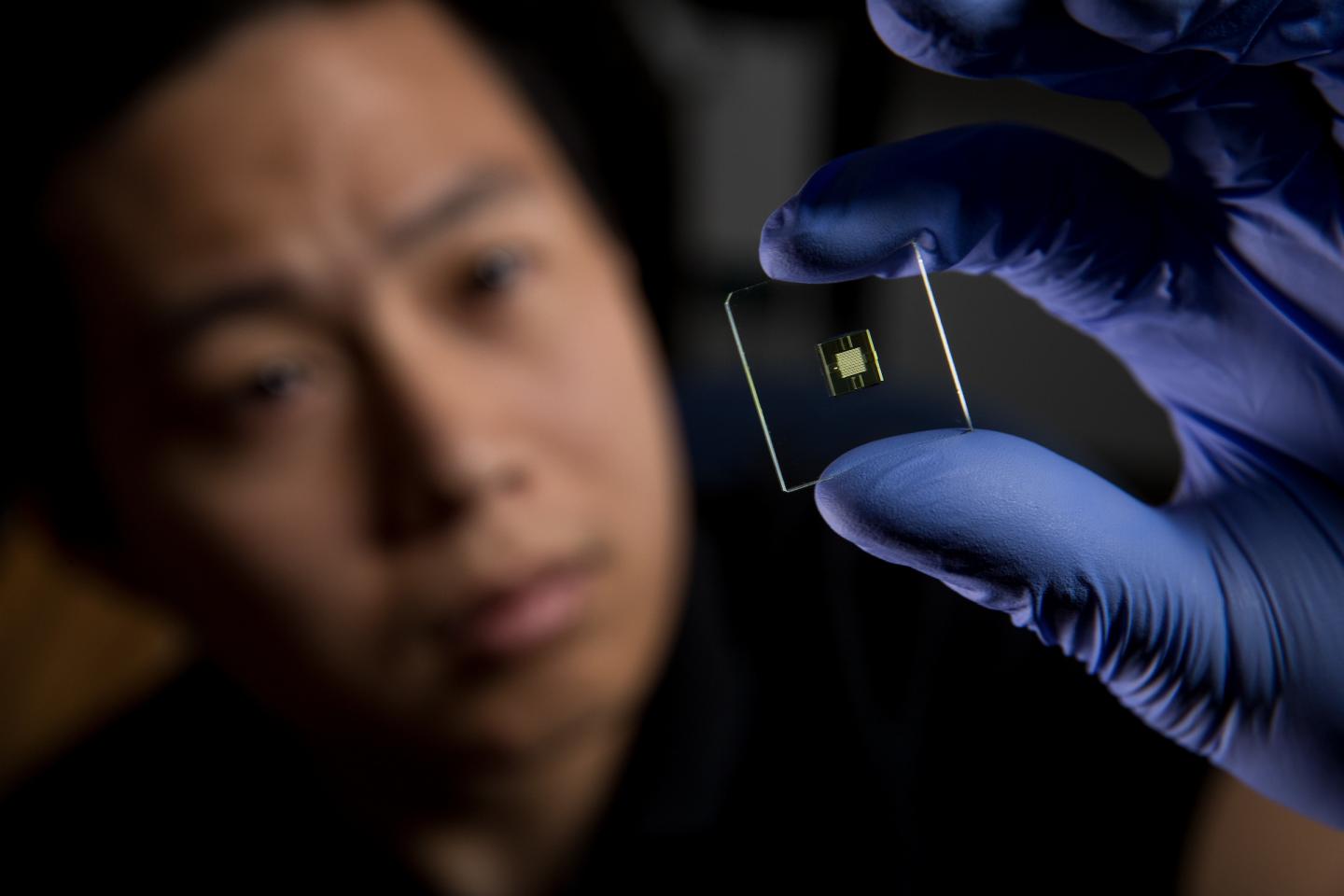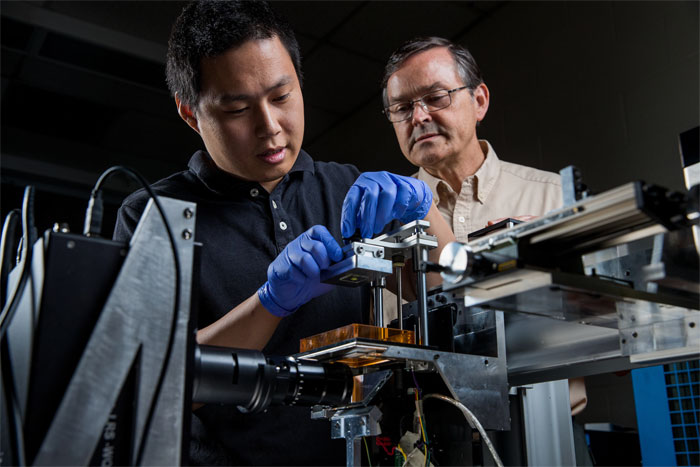
DLP-SLA Enables 3D Printing of Labs-on-a-Chip
source:photonics
release:Nick
keywords: 3D printer Laser application
Time:2017-08-21
PROVO, Utah, Aug. 15, 2017 — A custom 3D printer built using digital light processor stereolithography (DLP-SLA) has demonstrated the ability to print a viable microfluidic device compact enough to achieve flow channel cross-sections as small as 18 μm × 20 μm. The 3D printer has a projected image plane resolution of 7.6 μm and uses a 385-nm LED.

Hua Gong, a Ph.D. student at BYU, holds up a 3D-printed microfluidic device. Courtesy of BYU Photo.
Researchers at Brigham Young University (BYU) also developed a low-cost, high-resolution resin. Beginning with 20 candidate absorbers, they used a novel mathematical model for characterizing the resin’s optical penetration depth based on the measurement of the absorber’s molar absorptivity. Use of a 385-nm LED significantly increased the available selection of UV absorbers for resin formulation, compared to 3D printers with 405-nm LEDs.
Researchers demonstrated the efficacy of their approach by fabricating 3D serpentine flow channels 41-mm long in a volume of only 0.12 mm, and by printing high aspect ratio flow channels less than 25-μm wide and 3-mm tall.
According to the researchers, previous efforts to 3D-print microfluidic devices have not been successful in achieving feature sizes in the true microfluidic regime, which is less than 100 µm.
“Others have 3D-printed fluidic channels, but they haven't been able to make them small enough for microfluidics,” professor Greg Nordin said. “So we decided to make our own 3D printer and research a resin that could do it.”
Professor Adam Woolley said the research represents an improvement of a factor of 100 on the size of features that could now be possible in 3D printed microfluidics. The DLP-SLA-based approach also reduces the time and support needed to 3D print a microfluidic device. It can create a device in 30 minutes’ time and doesn’t require the use of a clean room.
“It’s not just a little step; it’s a huge leap from one size regime to a previously inaccessible size regime for 3D printing,” Woolley said. “It opens up a lot of doors for making microfluidics more easily and inexpensively.”
Nordin said that DLP-SLA is an especially promising lower-cost approach to 3D printing microfluidic devices. The technique uses a micromirror array chip to dynamically create the optical pattern for each layer during layer-by-layer printing of a device.

Microfluidic devices are tiny chips that can differentiate disease biomarkers, cells and other small structures In samples by using microscopic channels incorporated into the devices. The discovery by the BYU research team could open the way toward inexpensive mass production of these devices.
The researchers say they are laying the foundation for 3D printing to challenge the dominance of conventional methods — soft lithography and hot embossing — of microfluidic prototyping and development.
“We’re deliberately trying to start a revolution in how microfluidic devices are fabricated,” Nordin said.

Hua Gong, a Ph.D. student at BYU, holds up a 3D-printed microfluidic device. Courtesy of BYU Photo.
Researchers at Brigham Young University (BYU) also developed a low-cost, high-resolution resin. Beginning with 20 candidate absorbers, they used a novel mathematical model for characterizing the resin’s optical penetration depth based on the measurement of the absorber’s molar absorptivity. Use of a 385-nm LED significantly increased the available selection of UV absorbers for resin formulation, compared to 3D printers with 405-nm LEDs.
Researchers demonstrated the efficacy of their approach by fabricating 3D serpentine flow channels 41-mm long in a volume of only 0.12 mm, and by printing high aspect ratio flow channels less than 25-μm wide and 3-mm tall.
According to the researchers, previous efforts to 3D-print microfluidic devices have not been successful in achieving feature sizes in the true microfluidic regime, which is less than 100 µm.
“Others have 3D-printed fluidic channels, but they haven't been able to make them small enough for microfluidics,” professor Greg Nordin said. “So we decided to make our own 3D printer and research a resin that could do it.”
Professor Adam Woolley said the research represents an improvement of a factor of 100 on the size of features that could now be possible in 3D printed microfluidics. The DLP-SLA-based approach also reduces the time and support needed to 3D print a microfluidic device. It can create a device in 30 minutes’ time and doesn’t require the use of a clean room.
“It’s not just a little step; it’s a huge leap from one size regime to a previously inaccessible size regime for 3D printing,” Woolley said. “It opens up a lot of doors for making microfluidics more easily and inexpensively.”
Nordin said that DLP-SLA is an especially promising lower-cost approach to 3D printing microfluidic devices. The technique uses a micromirror array chip to dynamically create the optical pattern for each layer during layer-by-layer printing of a device.

Microfluidic devices are tiny chips that can differentiate disease biomarkers, cells and other small structures In samples by using microscopic channels incorporated into the devices. The discovery by the BYU research team could open the way toward inexpensive mass production of these devices.
The researchers say they are laying the foundation for 3D printing to challenge the dominance of conventional methods — soft lithography and hot embossing — of microfluidic prototyping and development.
“We’re deliberately trying to start a revolution in how microfluidic devices are fabricated,” Nordin said.
MOST READ
- RoboSense is to Produce the First Chinese Multi-beam LiDAR
- China is to Accelerate the Development of Laser Hardening Application
- Han’s Laser Buys Canadian Fiber Specialist CorActive
- SPI Lasers continues it expansion in China, appointing a dedicated Sales Director
- Laser Coating Removal Robot for Aircraft
PRODUCTS
 FISBA exhibits Customized Solutions for Minimally Invasive Medical Endoscopic Devices at COMPAMED in
FISBA exhibits Customized Solutions for Minimally Invasive Medical Endoscopic Devices at COMPAMED in New Active Alignment System for the Coupling of Photonic Structures to Fiber Arrays
New Active Alignment System for the Coupling of Photonic Structures to Fiber Arrays A new industrial compression module by Amplitude
A new industrial compression module by Amplitude Menhir Photonics Introduces the MENHIR-1550 The Industry's First Turnkey Femtosecond Laser of
Menhir Photonics Introduces the MENHIR-1550 The Industry's First Turnkey Femtosecond Laser of Shenzhen DNE Laser introduced new generation D-FAST cutting machine (12000 W)
more>>
Shenzhen DNE Laser introduced new generation D-FAST cutting machine (12000 W)
more>>
